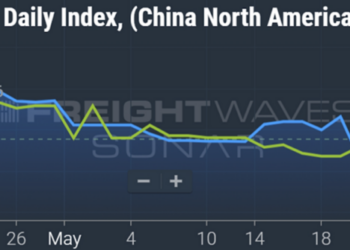Welcome to Check Call, our corner of the internet for all things 3PL, freight broker and supply chain. Check Call the podcast comes out every Tuesday at 12:30 p.m. EDT. Catch up on previous episodes here. If this was forwarded to you, sign up for Check Call the newsletter here.
In this edition: The Super Bowl and logistics, capacity begins to tighten and big jumps in the final-mile space.
In honor of the Super Bowl coming up this weekend in Las Vegas, let’s take a look at the logistics behind getting the biggest football game of the year off the ground. The 2020 Super Bowl rematch is in Sin City, which has been the host of some significant events this year, most notably the F1 race that made headlines in more than one way with some major snafus and hiccups for the best-laid plans.
Hopefully the same doesn’t happen with the Super Bowl, being played at Allegian Stadium at the end of the Las Vegas Strip. The stadium holds about 65,000, making it the fourth-smallest NFL stadium. That fact might be why the cheapest ticket into the big game is over $5,000.
Then there is the halftime show, which is a feat in and of itself. The stage has to be set up in the minute the first half of the game ends. The stage is wheeled out to the field with audio equipment and everything the performers need. All the equipment arrives days before the event in 200-350 trucks.
Months of preparations and well-planned rehearsals and the logistics of getting an entire team and equipment to the stadium is a massive accomplishment, but what about the fans?
The Super Bowl is the second-biggest eating day of the year after Thanksgiving, and once again it’s a bad time to be poultry. Roughly 1.45 billion chicken wings are consumed during the Super Bowl. Wings aren’t alone.
Here’s the math on how many 40,000-pound loaded trucks it would take to get Americans’ favorite game day snacks to the fan’s homes, not accounting for packaging or air in the bags (looking at you chips):
Chicken wings – 36,250 (1.45 billion pounds total).
Potato chips – 280 (11.2 million pounds).
Avocados – 3,485 (139.4 million pounds).
Popcorn – 95 (3.8 million pounds).
Nuts – 75 (3 million pounds).
Beer – 68,589 (325.5 million gallons).
Bacon – 312 (12.5 million pounds).
Ribs – 250 (10 million pounds).
Tortilla Chips – 205 (8.2 million pounds).
Cheese – 2,200 (88 million pounds).
That’s just for the fans at home – not counting the ones in the stadium. Either way you spin it, that’s a lot of freight to move in a short period of time. Had to be a nice bump for a few weeks to an otherwise bleak and quiet January freight market.
May the odds be ever in your favor this weekend, whether you root for the Chiefs, the 49ers, the halftime show or a national anthem under two minutes.
TRAC Tuesday. This week’s TRAC lane is from Atlanta to Nashville, Tennessee. This lane is on the up and up ever so slightly as February gets underway. An all-in rate of about $700, before margin, should secure this 247-mile trip with little issue. Capacity is tightening a little in Atlanta as both outbound tender volumes and outbound tender rejections are on the rise. The market to watch for rate volatility is going to be Nashville as outbound tender rejection rates have increased 502 basis points week over week from 5.36% to 8.91%. That should put strain on capacity, making spot rates rise and taking outbound tender lead times with them. Something to watch for those covering loads out of Nashville.
Who’s with whom? Onward ho! The phrase signals new adventures and uncharted territory, something that Onward, a final-mile logistics company, is experiencing with the acquisition of HOW Logistics Group, a smaller 3PL that also specializes in the final mile. It appears that Onward has acquired HOW for the network and scalability of the company. Onward is currently striving to be the answer to the underutilized capacity of box truck fleets.
Steve Nelson, CEO of HOW Logistics Group, said in a news release: “For years the last mile, white glove, big and bulky vertical has struggled with understanding capacity, coverage and the true nature of partnership with the most important part of this being the final mile agent. Onward’s dynamic platform and marketplace brings together the opportunity to educate both the agent and forwarder on each other’s KPIs and align them under a single platform all striving towards a single north star.”
A trend of technology development and process improvement that has been a constant in the dry van world for years has rippled out to the other specialty spaces in hopes to bring the same streamlined efficiency to other arenas as well. That only serves to benefit the entire supply chain.
The more you know
How have Red Sea attacks by Yemen’s Houthi fighters affected companies?
3PLs Penske Logistics, Kenco lay off combined 300
Loop announces new reverse logistics offerings to transform operations and boost retail margins
Borderlands: Mexico’s truckers plan nationwide strike against cargo theft
Uber Freight begins piloting the Scheduling Standards Consortium’s protocols
The post No logistics, no football appeared first on FreightWaves.














